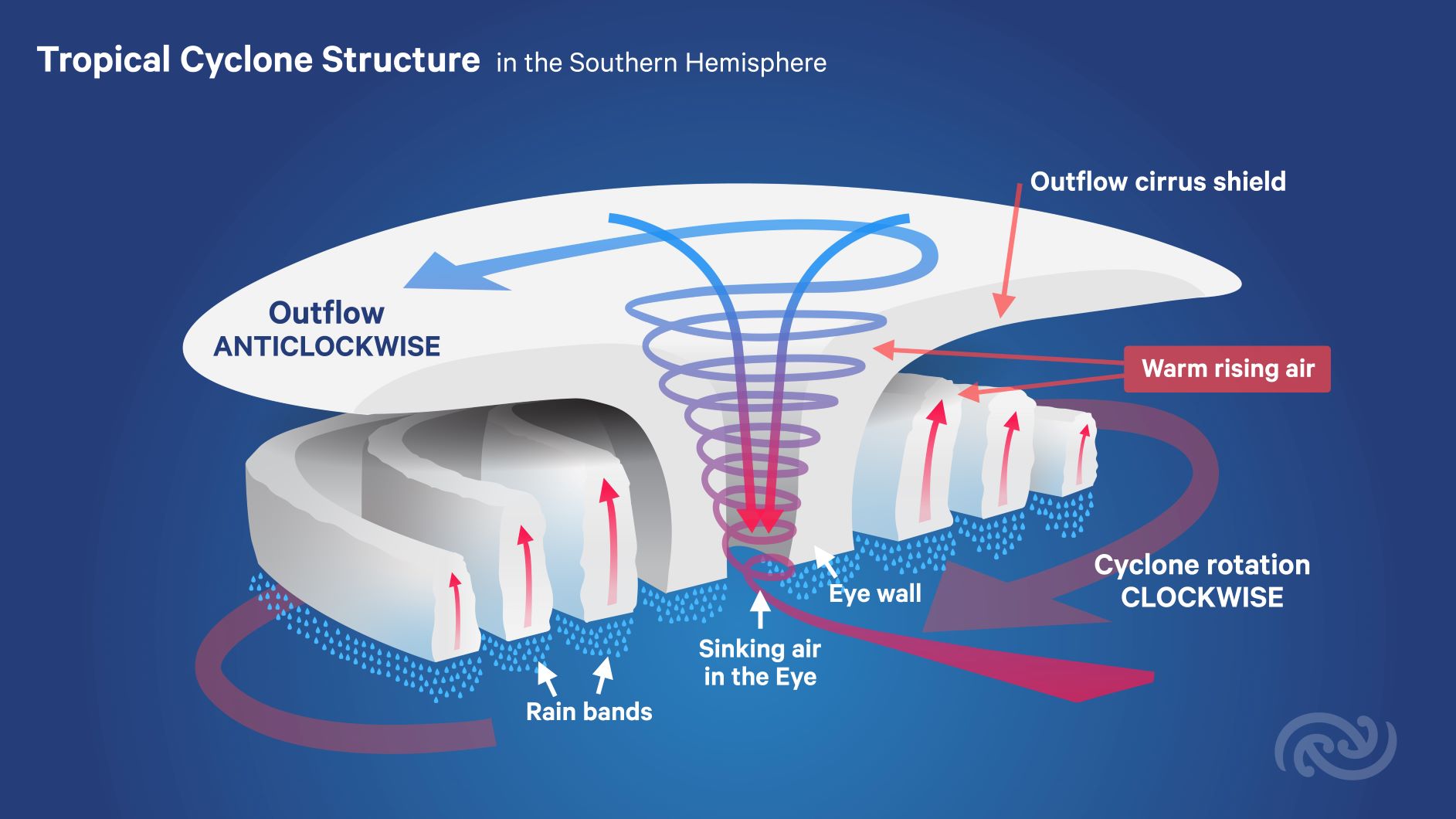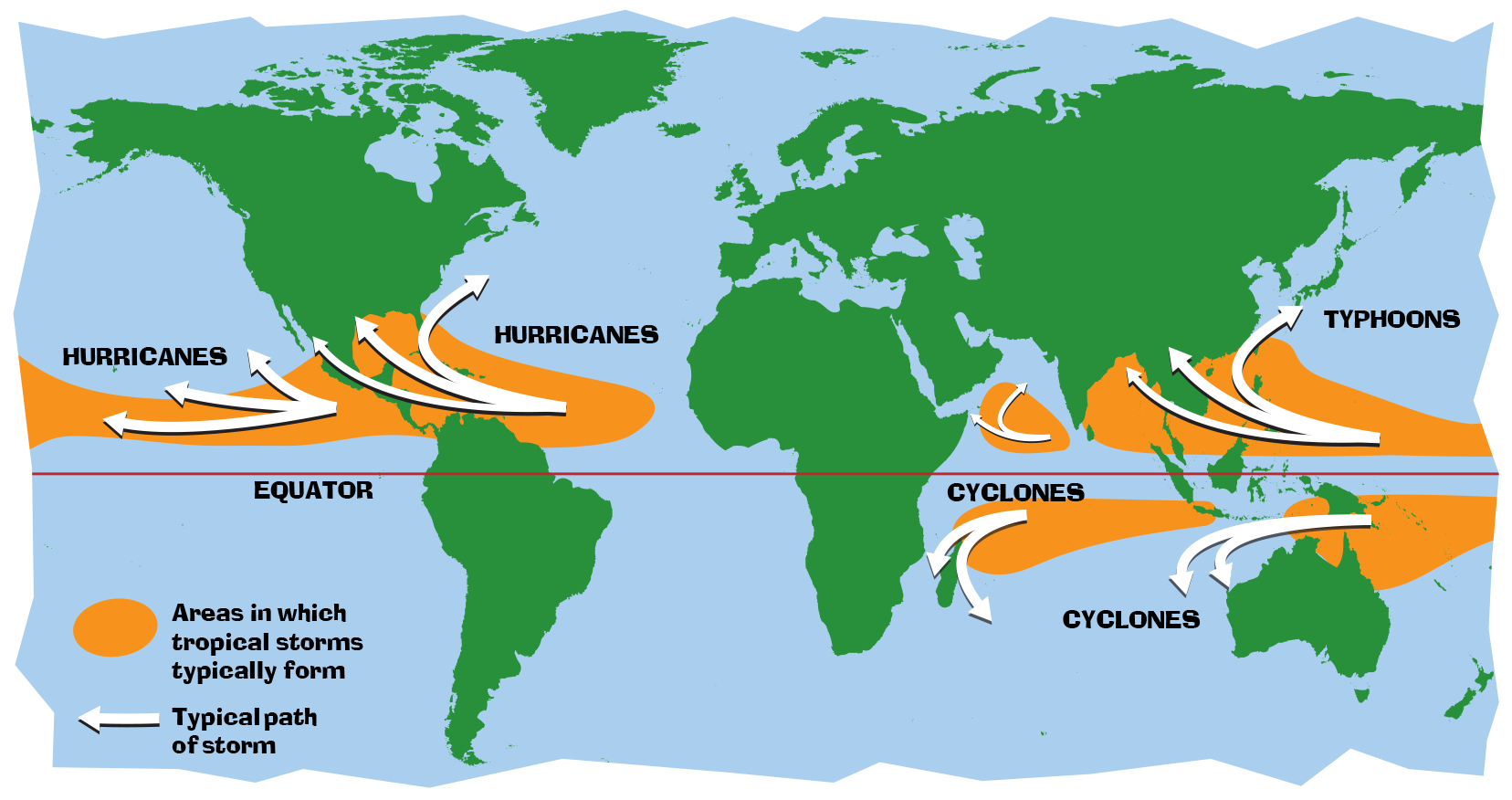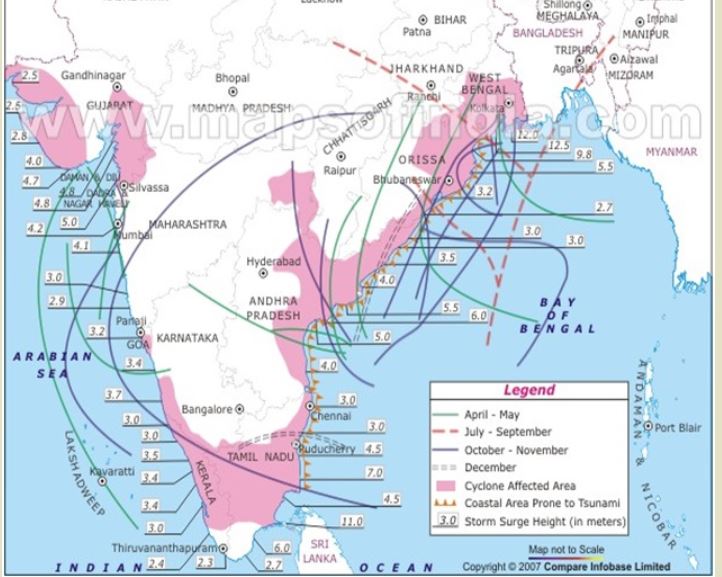All about Cyclones
2020 MAY 17
Mains >
Geography > Climatology > Disaster risk reduction

IN NEWS:
- India’s eastern coast is gearing up to deal with the potential impact of a pre-monsoon cyclonic storm named Amphan.
TROPICAL CYCLONES:
- A cyclone is a system of winds which rotate inwardly to an area of low atmospheric pressure. They are of types: Tropical cyclones and Temperate (extra tropical) cyclones.
- A tropical cyclone is one that originates in the tropical region.
- The ideal conditions for their formation are:
- Warm sea surface, with temperatures > 27 °C
- Presence of Coriolis force
-
- Pre-existing low-pressure cyclonic circulation
- Small differences in vertical wind speed
- Upper air divergence
- They form only over warm water bodies because the energy that drives these storms comes from the condensation of warm water within the cumulonimbus clouds surrounding the centre of the storm.
- Due to the effect of Coriolis force, the winds rotate anti-clockwise in the northern hemisphere and clockwise in the southern hemisphere.
- Movement in Northern hemisphere:
- They initially start with a westward movement under the influence of earth rotation and the Easterlies.
- As they move to higher latitudes, the Coriolis force becomes stronger and deflects the system to the right- towards north and later to the east.
- Once the winds reach 30° latitude, the seas are not warm enough to drive the winds and hence they subside.
- Regional names:

CATEGORIZATION OF CYCLONES:
- The criteria followed by Meteorological Department of India (IMD) to classify the low-pressure systems in the Bay of Bengal and in the Arabian Sea as adopted by World Meteorological Organisation (WMO) are as under:
.JPG)

NAMING OF CYCLONES:
- The naming of cyclones that form in every ocean basin across the world is carried out by the Regional Specialised Meteorological Centres (RSMCs) and Tropical Cyclone Warning Centres (TCWCs).
- For north Indian Ocean including Bay of Bengal and Arabian Sea, the RSMC, New Delhi assigns the name to tropical cyclones following a standard procedure.
- The WMO/ESCAP Panel on Tropical Cyclones in 2000 agreed in principle to assign names to the tropical cyclones in the Bay of Bengal and Arabian Sea. Each country would sent their suggestions, based on which the Panel would finalise a list.
- Generally, names of some storms that cause widespread damage and deaths are usually retired and are not brought back or reused later, at least for 10 years. These names are then replaced with new names.
- Unlike in other regions, the names of tropical cyclones over the north Indian Ocean once used, will cease to be used again.
DESTRUCTION CAUSED BY CYCLONES:
There are three elements associated with cyclones which cause destruction during its occurrence. These are:
- Strong Winds/Squall: Cyclones are known to cause severe damage to infrastructure through high speed winds. Very strong winds which accompany a cyclonic storm damages installation, dwellings etc., resulting in loss of life and property.
- Torrential rains and inland flooding: Torrential rainfall that accompany the cyclones gives rise to unprecedented floods. Heavy rainfall from a cyclone is usually spread over wide area and cause large scale soil erosion and weakening of embankments.
- Storm Surge: A Storm surge is an abnormal rise in sea level near the coast caused by a severe tropical cyclone. As a result of this, sea water inundates low lying areas of coastal regions, causes severe floods, eroding beaches and embankments, destroys vegetation and leads to reduction of soil fertility.
INDIA’S VULNERABILITY TO CYCLONES:
- India, having a coast line of 7500 kms and 40% of the total population living near a coastline, is exposed to nearly 10% of the world’s Tropical Cyclones. The region has the highest population density and shallowest coastal bathymetry in the world, making it highly vulnerable to storm surge.
- There are 13 coastal states/UTs encompassing 84 coastal districts which are affected by cyclones. Of these, Andhra Pradesh, Odisha, Tamil Nadu and West Bengal, Pondicherry and Gujarat are the most vulnerable.
- Although cyclones affect the entire coast of India, the East Coast is more prone compared to the West Coast.

NATIONAL CYCLONE RISK MITIGATION PROJECT (NCRMP):
- The Government initiated the National Cyclone Risk Mitigation Project (NCRMP) with World Bank assistance to address cyclone risks in the country through suitable structural and non-structural measures.
- The Project development objective of the NCRMP is to reduce vulnerability of coastal communities to cyclone and other hydro meteorological hazards through
- Improved early warning dissemination systems
- Enhanced capacity of local communities to respond to disasters
- Improved access to emergency shelter, evacuation, and protection against wind storms, flooding and storm surge in high areas
- Strengthening DRM capacity at central, state and local levels in order to enable mainstreaming of risk mitigation measures into the overall development agenda.
- The Project has identified 13 cyclone prone States and UTs, which have further been classified into two categories:
- Category I: Higher vulnerability States, which includes Andhra Pradesh, Gujarat, Odisha, Tamil Nadu and West Bengal.
- Category II: Lower vulnerability States which includes Maharashtra, Karnataka, Kerala, Goa, Pondicherry, Lakshadweep, Daman and Diu, Andaman and Nicobar Islands.
- National Disaster Management Authority (NDMA) will implement the Project in coordination with State Governments and the National Institute for Disaster Management (NIDM).
PRACTICE QUESTION:
Q. Discuss the formation and impact of tropical cyclones?
Source: Down To Earth

